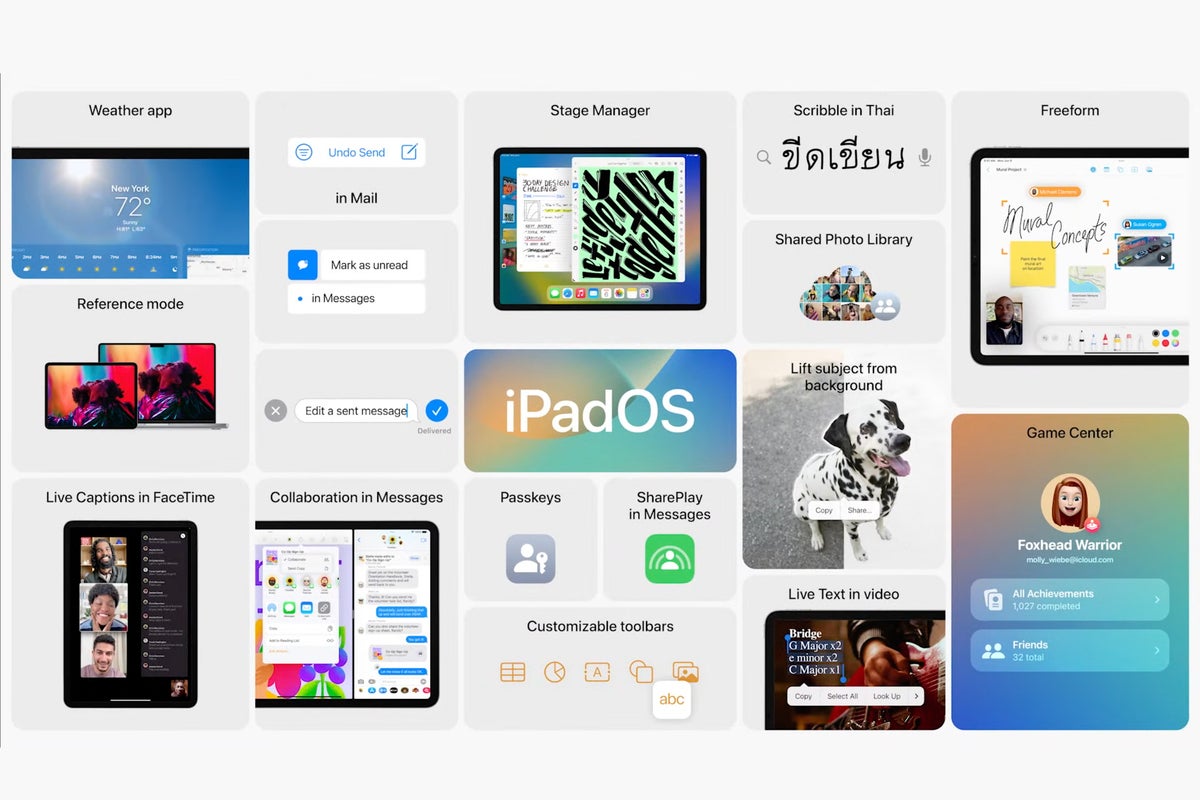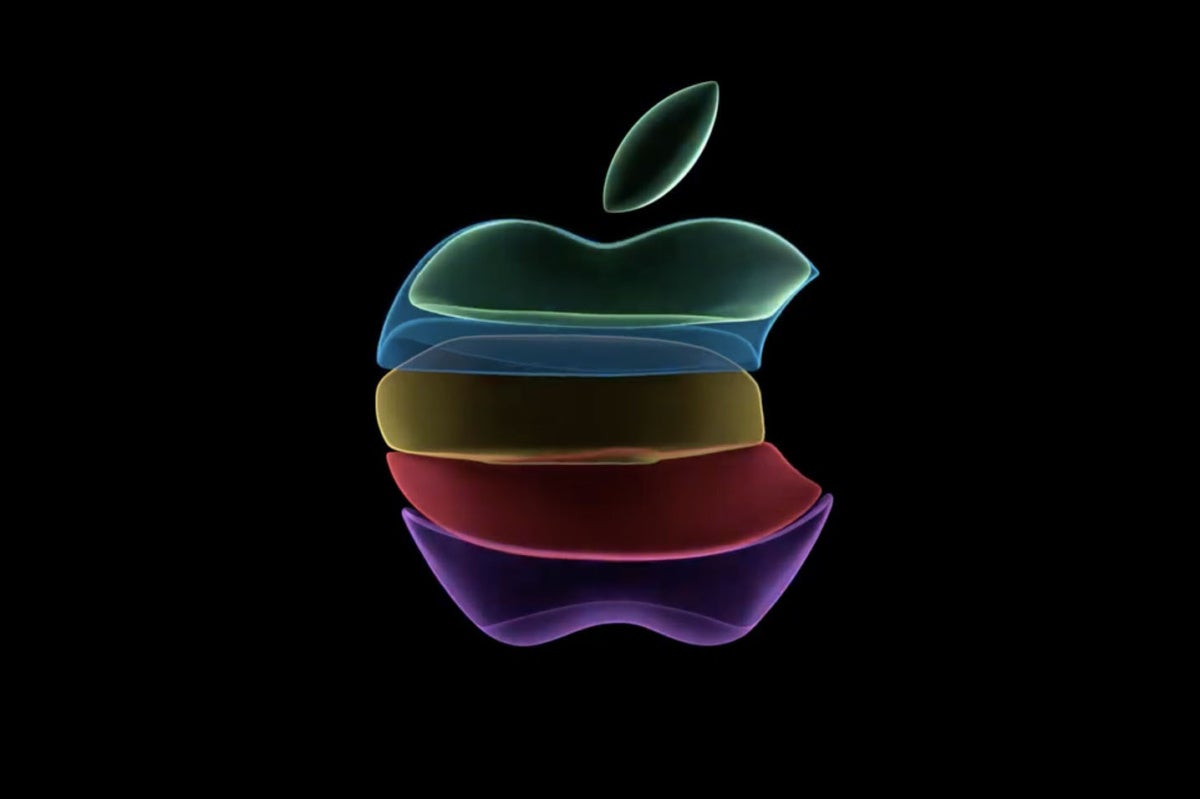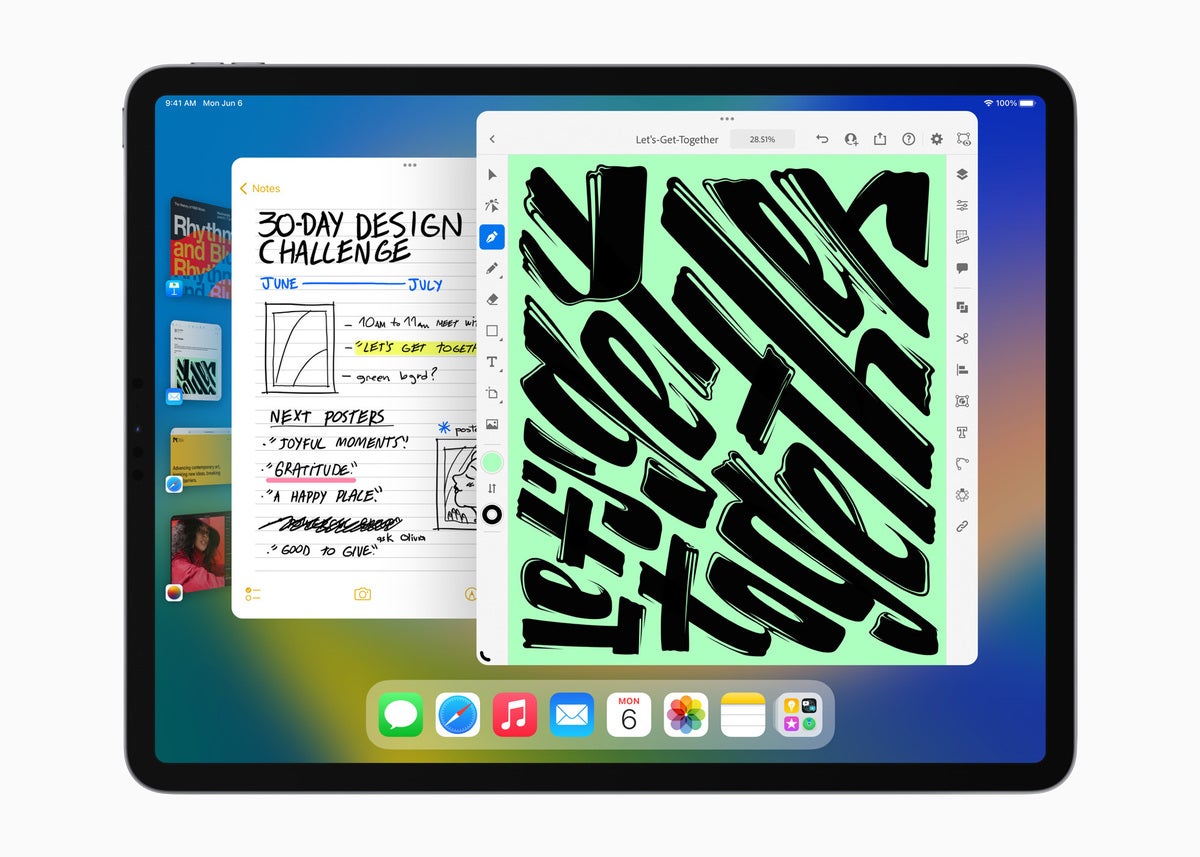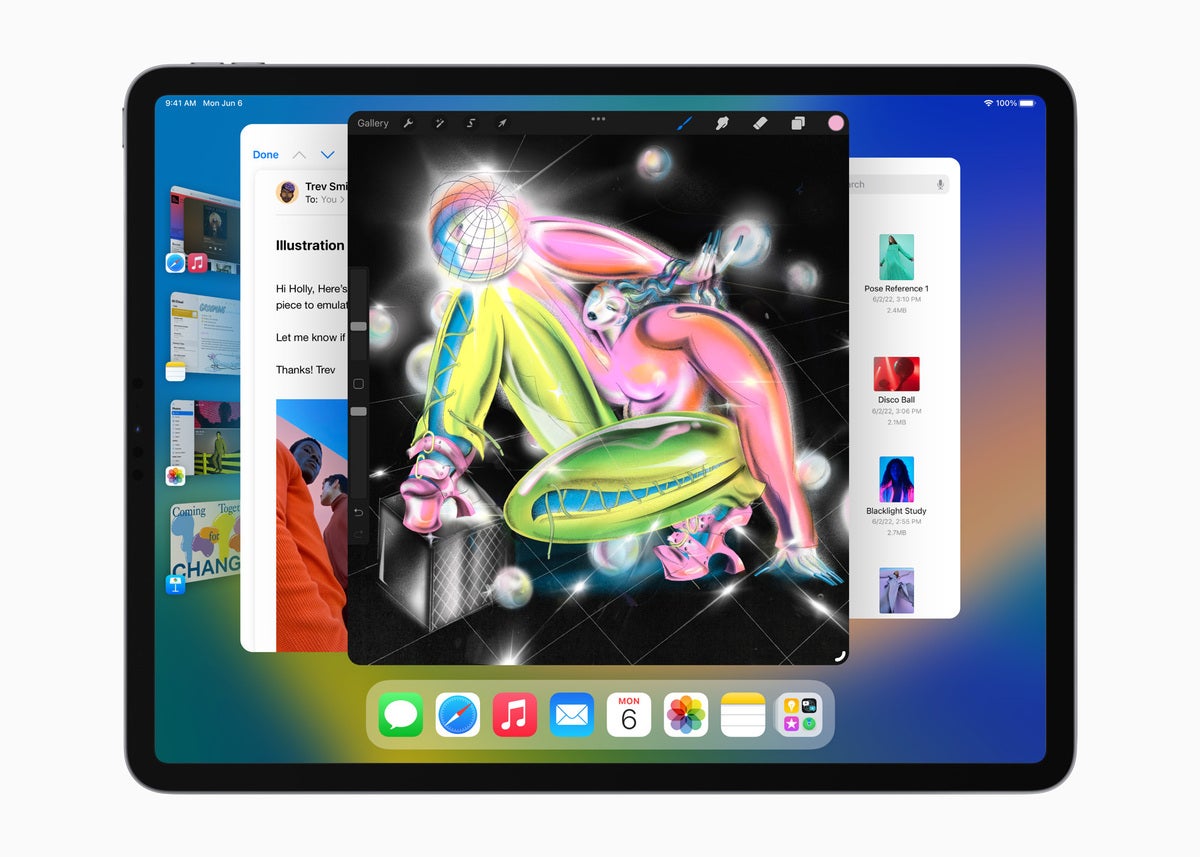[ad_1]
Audio
Join Macworld’s Michael Simon and Computerworld’s Ken Mingus as they discuss Apple product lineup as we head into the all-important holiday shopping season.
Copyright © 2022 IDG Communications, Inc.
[ad_2]

[ad_1]
Audio
Join Macworld’s Michael Simon and Computerworld’s Ken Mingus as they discuss Apple product lineup as we head into the all-important holiday shopping season.
Copyright © 2022 IDG Communications, Inc.

[ad_1]
For knowledge workers, location flexibility significantly improves outcomes related to innovation, wellbeing, burnout, and perceptions of organizational culture, according to the 2022 State of Teams report from work management company Atlassian.
The research consisted of responses from 1710 knowledge workers across Australia and the U.S., between 21 and 65 years old, operating in teams. The sample comprised 43% women and 57% men.
The main findings outlined that teams have an equal shot at success regardless of where they work, with the improved outcomes regarding wellbeing and innovation creating a ripple effect that yields even more favorable outcomes.
The report further stated that flexibility is linked to positive perceptions of an organization’s culture, which in turn is strongly associated with higher employee retention rates. Plus, people from hybrid and distributed companies are more likely to identify their teams as innovative.
However, providing employees with the ability to work in a distributed way is not without its challenges. Atlassian’s research also found that when people have different schedules, it can be harder for teams to stay aligned on the specific tasks under way.
The research also found that people with greater location flexibility are more susceptible to imposter syndrome, perhaps because they’re less likely to get incidental positive feedback and cues from colleagues when they’re physically separated.
Annie Dean, head of Team Anywhere at Atlassian, said that while the responses were collected in the U.S. and Australia, Atlassian suspects most global teams can relate to the trends identified in the report.
Dean added that since Atlassian announced its own distributed work policy over two years ago, the company has reaped many of the benefits that come from giving employees more flexibility. However, Dean said that this doesn’t mean Atlassian hasn’t also faced many of the same challenges that surfaced in the research.
“As the makers of collaboration software, we make it our job to understand the challenges of distributed work, share what we learn along the way, and then bake those learnings into our product innovation,” Dean said. As a result, Dean added that it was “no coincidence” that many of the new products and features Atlassian has recently introduced directly address the pain points identified by this research.
While location flexibility is linked to improved company culture, which in turn is often associated with higher employee retention rates, the report found that there are still a number of challenges facing distributed workforces.
Among the positive workplace trends that were highlighted by the research, 78% of people surveyed said they’re enthusiastic about their work, up 9% from last year’s survey, with 75% of respondents stating that respect for different views and perspectives is the norm on their team. In Atlassian’s 2021 survey, that figure was 66%.
Another statistic that has also improved from last year was the percentage of respondents reporting that they have visibility into how decisions are being made—63% in this year’s survey, compared to 51% in 2021. Furthermore, this trend appears to track in line with increased trust in leadership, which rose by 11% year over year.
However, there continues to be a number of challenges facing distributed teams, and Atlassian found that more people are now pointing to factors in their personal lives that make it harder to do their work—33% this year compared to 26% last year. The report suggests that this indicates that mental health and financial challenges caused by the pandemic persist.
Additionally, the research found that among teams that were self-described as being “innovative,” 42% of respondents acknowledge they exhibit at least one sign of impostor syndrome. Since Atlassian’s data also shows strong links between impostor syndrome and reduced engagement, the company noted that it’s “vital for leaders to make sure the merits and limitations of an idea get equal airtime.”
Atlassian also reported a challenge related to virtual meetings. While office-only workers have around five hours of meetings in an average week, for people on distributed and hybrid teams that figure is closer to eight hours. As a result, the research found that spending more time in meetings is linked with a significantly higher risk of burnout, with 31% of respondents who had over 20 hours of meetings scheduled per week expressed that they were experiencing one or more signs of burnout, compared to 23% of those who had 15 hours of meetings or less.
Dean said that after collating the research, many of the trends did hold true, based on conversations Atlassian has had with customers, alongside the company’s own experiences as a distributed team.
“One of the data points that did raise my eyebrows was related to imposter syndrome,” Dean said, highlighting the surprisingly high percentage of respondents reporting this feeling.
Dean said that where this is caused, at least in part, by a culture that emphasizes brainstorming, critique, and providing instant feedback, its important leaders use tools and practices that allow all ideas to be shared in both synchronous and asynchronous manners.
“It’s also important to find opportunities for spontaneous high-fives and other incidental positive feedback when we work distributed,” Dean said.
Copyright © 2022 IDG Communications, Inc.
[ad_2]

[ad_1]
Apple remains the most resilient FAANG business. While other big tech firms (like Alphabet and Microsoft and Facebook) report grim news, Apple managed to set fresh records, increased Android-to-iPhone switching numbers, but still slightly missed expectations.
The company reported its Q4 earnings late Thursday.
Overall, Apple’s quarterly results were decent in what was an otherwise terrible tech week. Total sales hit a new record $90.1 billion, up 8% YoY for earnings of $1.29 per share.
Wall Street’s consensus expectations had hovered around 88.9 billion for $1.27 per share. (It is worth noting that estimates from Morgan Stanley’s new Apple analyst, Erik Woodring, came closest of all). Gross margins hit 42.3%.
However, relative weakness in some segments speak to the challenges we all face. “We are still living through unprecedented times,” CEO Tim Cook said, citing economic challenges, war in Ukraine, COVID-19, and climate-related crises. “The world continues to be unpredictable.”
On an annual basis, revenue reached a new record $394.3 billion, up 8%.
Despite challenges, net sales increased in every region except Japan — with new records in India. Apple also increased revenue in every segment, except iPad, though the rate of growth in some areas seems in flux.
Looking forward, company execs seemed as confident as anyone can be in such a febrile economic environment. “Revenue performance will decelerate during the December quarter,” they warned, citing foreign exchange fluctuations as one big barrier.
In a more stable currency environment in which foreign exchange challenges had not reduced revenues by 600 basis points, Apple would have delivered better than 14% YoY revenue growth.
As it is, in the upcoming quarter, management suggested 8% YoY growth. It may help that Apple’s December quarter will be one week longer than usual.
iPhone sales came in lighter than expected, but the slight softness was more than compensated for by strong Mac sales. The company no longer breaks out numbers, but reported iPhone sales of $42.6 billion, up 9.7% but slightly under consensus expectations for $43.4 billion in sales. That’s still way ahead of the wider smartphone industry — Apple is generating share in comparison.
We have heard speculation that consumers who are purchasing iPhones are choosing to invest in the Pro devices, above the standard range, which does hint that overall sales numbers may have declined a little, in line with the wider industry trend. (This is offset by a higher average spend per user.)
“We had three of the top four smartphones in the US, in the UK, the top three in urban China, the top six in Australia, four out of the top five in Germany and the top two in Japan,” he said. “Customer satisfaction for the iPhone remains very, very strong at 98%.
“We feel very good about how we performed in Q4 and the certainly the start of this generation [of iPhone] would suggest that we’re going to be constrained for a little while on the 14 Pro and 14 Pro Max, but we’re working very hard to try to remedy that,” said Cook.
Services income reached $19.2 billion, up 5%. Analysts were disappointed, given the double digit growth we’ve seen in the category so far. They had anticipated $20.1 billion.
The good news is that Apple now has more than 900 million subscribers to its services, up 155 million in the last 12 months. Apple CFO Luca Maestri pointed out that digital advertising and gaming were weak.
Apple recently increased prices across some of its services. It claims this reflects higher levels of music royalty.
That decision, combined with what appears to be slowing pace of growth in the segment, suggests the company may soon need to grapple with the problem of churn, as consumers face multiple challenges. Though Apple did explain that in the context of stable foreign currency exchanges the segment would have delivered double-digit growth.
It’s worth noting that Apple is expected to widen its catalog of available sports entertainment programming on TV+, which may help both boost sign-ups and mitigate churn.
Mac sales climbed an impressive 25%, reaching $11.5 billion. “It was the best quarter [for the Mac] we’ve ever had in the history of the company,” said Cook.
He said a backlog of Mac demand the company was unable to fulfil in Q3 because of Covid-related factory shut downs did help boost Apple’s Q4. But he also pointed to strength in sales from the introduction of the M2 MacBook Air.
iPad revenue was $7.2 billion. That’s down 13.1%. To explain this, Cook tried to argue that while new iPads were introduced in time to impact results in the year-ago quarter, this was not the case this year, with iPads introduced in October.
One positive point Apple management highlighted: the iPad installed base is now at its highest —and that over half of those purchasing iPads during the quarter were new to the product.
Wearables and accessories reached $9.6 billion, up 9.8%. Cook confirmed the new Apple Watch Ultra has been popular, confessing that supply of the device remains constrained.
Beyond the standard numbers, Apple threw in some highly significant nuggets of information. It continues to generate healthy sales to people new to its offerings. More than 50% of iPad sales and “over two-thirds” of Apple Watch sales went to consumers who had never owned one of those products before.
It also generated record sales in India and increased revenues in China. Sales also doubled in Thailand, Vietnam, Indonesia, and Mexico, proving the company’s focus on expanding its markets.
“Like other major tech companies, even Apple is suffering from the negative impact of a worsening macro backdrop and ongoing supply chain woes, though it has done a better job of navigating through the challenging environment,” said Jesse Cohen, senior analyst at Investing.com
From the balance sheet, it’s clear that Apple continues to invest in the next big thing(s). Research and development spending hit $6.7 billion in the quarter, up from $5.7 billion a year ago. Spending on this has reached $26.2 billion, up from $21.9 billion. It’s hard not to imagine Apple’s working on something — particularly as the company continues to make around “one acquisition per month,” according to Cook.
“As we head into the holiday season with our most powerful lineup ever, we are leading with our values in every action we take and every decision we make,” Cook said. “We are deeply committed to protecting the environment, to securing user privacy, to strengthening accessibility, and to creating products and services that can unlock humanity’s full creative potential.”
Apple’s board of directors has declared a cash dividend of 23 cents per share of the Company’s common stock.
Please follow me on Twitter, or join me in the AppleHolic’s bar & grill and Apple Discussions groups on MeWe.
Copyright © 2022 IDG Communications, Inc.
[ad_2]

[ad_1]
The COVID-19 pandemic was, no doubt, an unusual event. But we’re likely to see more such crises in the future. How successfully we handle them will depend on what happens and how politicians and corporate executives respond. One thing that’s clear is that flexibility and foresight will be needed as companies sort out what comes next.
For example, it seemed clear a year ago that practically everyone in office jobs would remain largely remote, so companies realized they needed occasional on-premises collaboration spaces that were small and intimate. (These were often called huddle rooms.)
Now, companies are talking about large conference rooms again as they envision people coming back to the office en masse — largely because they never addressed the issues that cropped up with the shift to remote work. Those problems include workers who felt like they didn’t have the same opportunities as on-site employees and managers who either don’t know how to manage remote employees or simply don’t trust them to do their jobs.
While part of the problem may well be poor management training, we’ll leave that for another day. But when it comes to setting up collaboration spaces for in-office and hybrid worker use, there are some things IT decision makers and business execs need to keep in mind.
I’ve been covering videoconferencing and collaboration since the late 1980s. There’s been a recurring cycle: companies get excited about a technology, invest in it, then lose interest to a degree that vendors exit the market, leaving customers exposed.
There are ways to avoid that — if you plan smartly.
First, when choosing a videoconferencing vendor, pick one that likely to survive market downturns so they’ll be around when you need them. Then, as you consider their platforms and software, you’ll want to look beyond price, ease of use, and ease of installation to determine how broad and flexible everything is. (By broad I mean how many of the videoconferencing back-end offerings it will work with). Not everyone will stay in this market and having expensive hardware that only supports a platform that no longer exists is … less than desirable.
Interoperability is important, too. A rich peripheral ecosystem offers options should any one provider leave the market, making it more likely the system will continue to work — and you’ll have more choices if you decide to replace it.
And you should go small. Rather than getting huge conferencing monitors built for large spaces, consider smaller, multiple-monitor configurations. This kind of setup can be, if necessary, broken up and moved to smaller rooms should that make more sense than one large setting. It’s important, too, to keep complexity low, as that keep support costs down and (hopefully) mean fewer problems for users.
Finally, and this goes beyond just the selection of technology, look at how these rooms are used and what savings you expect (in terms of travel costs and productivity costs). That way, you can craft long-term policies that continue to ensure the investment will be protected.
Videoconferencing has been a critical way for companies to carry on since the pandemic arrived in 2020. Now that the pandemic focus has waned, we seem to be slowly going back to the way things were (with some companies moving faster than others). This changes not only how videoconferencing spaces should be set up, but whether they might be used at all.
As companies (and workers)have learned, the cost benefit of these rooms in terms of reducing travel and commuting costs is significant. That alone should justify their continued use — but only if those savings are captured and incorporated in decisions about whether people should be forced back to the office.
Bottom line: We are not only not done with this pandemic, but it’s likely we’ll have others going forward. So it’s critical to develop a long-term remote strategy now that includes well-planned videoconferencing and collaboration spaces, management training, and remote management tools.
The goal is to make sure remote employees get the face time and relationship-building they need and companies get to a sustainable, steady state where everyone can work together, regardless of what’s happening in the world.
Copyright © 2022 IDG Communications, Inc.
[ad_2]

Apple today is expected to release iPadOS 16.1. Most of its improvements aren’t confined to iPad — you’ll also find them on iOS 16 and macOS Ventura. But they should help you be more productive, whichever Apple device you use.
Here’s a look at some of the improvements and what they do.
Stage Manager (see more below) tries to bring both Mac and iPad closer together, but iPad gains new system elements and interactions in the Desktop Class apps, including Files. These include consistent undo and redo, customizable toolbars, and the ability to change file extensions and view folder sizes in Files. This alone may be enough to upgrade, given how important Files has become for some workflows.
As I mentioned, most of the best improvements in iPadOS 16 are shared across all of Apple’s platforms. Take the new smart tools in Mail, which let you cancel an outgoing message, schedule email send,s and set reminders. Just as on Macs, iPads can do all this and tip you off if you forget to include to add attachments to your message. Search has also been improved: it can handle typos better, use synonyms and will provide much richer mail search results.
The latest big change in the iPad user interface is also shared with the Mac. Stage Manager attempts to build a new logic to how you handle applications on both systems. In theory, it’s practical: it makes it far easier to move between different applications, or groups of applications and helps by keeping the application you are currently working with front and center. In practice, beta testers seemed to find the new UI more effective on Macs than iPads, but once people get used to it, the move may help bridge the ever-shrinking gap between the unique nature of both systems.
Stage Manager represents a major change in how windows and apps are organized on the iPad.
It’s not available in this release, but Freeform promises so much for all of us. It’s a form of collaborative notebook into which users can share diagrams and plot plans in one fully editable shared workspace. Freeform works with Messages and FaceTime, so you can work with people and track changes asynchronously.
Shared tab groups, better password management thanks to Passkeys, and new dedicated start pages for specific Tab Groups should all go some way to improve and secure the experience of using Safari. If you are a visual thinker, you can customize Tab Group start pages with background images, bookmarks and sections that can be shared with others.
Live Text was already an amazing tool to recognize words, such as street signs or notices in photos. In iPadOS 16, it can also recognize words in videos. You can translate words, drag and drop them into other application,s and more. Improvements in Visual Look Up mean you can recognize animals, insects, birds, flowers, and statues from photos. Essentially, photos and videos on iPads and other Apple devices have become functionally useful tools, particularly for education, report creation, and travel.
Support for 20 more languages in VoiceOver means even more people in even more nations can use iPads to get things done via voice, while Notes gains Smart Folders and a host of additional refinements to make notes easier to make, manage, and share.
If you’re one of the millions who seem to spend a lot of time in video meetings, Handoff in FaceTime makes it easier to slip between devices mid-meeting. It would be even better if you gained this facility in Zoom, Teams, and Webex, given those are where most work now gets done.
Finally, Display Zoom helps you maximize available space on your iPad display, so icons and font sizes shrink to make way for what you need.
iPadOS 16 desktop.
iPads can detect the second-generation Apple Pencil when it hovers from about 12mm above the display. When it detects the implement, the display will show you a preview of the mark to help you place it more accurately. That means more accuracy when you use Scribble, fewer errors when annotating documents or PDFs, and one big limitation: Hover is only available to M2-equipped iPad Pros.
You can also plug your iPad into an external display. If you are using a high-end new iPad Pro you can also use Reference Mode, which matches color requirements and manages colour accuracy — that’s useful for film and photography professionals who will now get to carry the world’s most lightweight reference display.
The Weather app at last makes it to iPad. It’s been a long and an unnecessary wait, but now it’s over. You, too, can swoon as those little drops of rain patter in the app on a wet day or enjoy the pale blue sunshine sky on days when it is bright. You’ll also get information on air quality and temperature and severe weather alerts.
Please follow me on Twitter, or join me in the AppleHolic’s bar & grill and Apple Discussions groups on MeWe.
Copyright © 2022 IDG Communications, Inc.
[ad_2]

[ad_1]
If an employee works two jobs, are they really stealing from your company?
I don’t think so, but Canopy CEO Davis Bell apparently does.
Bell, whose company is a midsized, Utah-based accounting practice management software firm, wrote on LinkedIn that he’d recently “fired two recent hire engineers who never quit their last job at a big tech company. The reason? This is not about side hustles or moonlighting. These were people holding down two, full-time synchronous jobs and lying about it — trying to be in two meetings at once, etc. Their early performance was really bad, and fortunately, we have great managers who sniffed them out very quickly.”
Okay, so far. I don’t care why someone’s performance is terrible — if they can’t do the job, then, after trying to get them up to speed, they’re out. If someone lies to me, they’re history. But, and this is where Bell and I run on separate tracks, if someone can do my job while doing another job, I’m fine with that.
Seriously.
As I’ve been saying for some time, it’s not just my opinion that shorter work weeks and working from home help with productivity. The proof is out there. And, if someone can be successful at working two jobs, more power to them.
According to Bell, there are, “Core moral issues at play: ‘working’ two full-time jobs is stealing, and it also involves a great deal of lying and deception.” Does it? In this case, no one was stealing. What I’d fire them for was lying and failing at the jobs.
I mean, Bell, himself, works two jobs. He’s both a CEO and has been an angel investor in 11 different companies during the last six years. If he’s doing justice to his “jobs,” then he’s undoubtedly working two full-time jobs. I don’t see anyone saying he’s stealing from his company.
Nor does anyone say Elon Musk, who’s running Tesla, SpaceX, The Boring Company, and Neuralink, and soon, maybe Twitter as well, is “stealing” from his stock owners?
Bell thinks this trend of people working two full-time jobs is “a new form of theft and deception and not something in which an ethical, honest person would participate.”
I disagree. I know many people who work two full-time jobs and side gigs as well. It’s called surviving. You see, not everyone is working multiple jobs to cash in. Many workers do it because they don’t have a choice. They do it because they’re struggling and need the income.
According to the US Census, long before COVID-19 changed the way we work, 8.3% of workers, 13 million, had more than one job. Their numbers have been increasing. And, even as they work themselves to the bone, they earn less than people with good full-time jobs. A Pew Research Center report, The State of Gig Work in 2021, showed many people rely on notoriously poorly paying gig work to make ends meet.
Of course, the attention this issue is getting today isn’t about the people working one job at McDonald’s and another at Wal-Mart. Unless you live in Silicon Valley or some other high-tech, high-cost area, software engineers don’t have to worry about keeping a roof over their heads. Instead, they’re seizing the opportunity to make as much money as they can while the making is good.
You see, despite all the headlines about FAANG and other large companies laying people off, the truth is that tech unemployment is at a mere 2.1%. And, for the first time, in 17 years, the average tech salary has cracked the six-figure barrier.
Still, today’s workers worry. The pandemic showed many of them there’s no guarantee that just because you have a job today, you’ll have one tomorrow. Many companies have also shown for ages that they have no loyalty whatsoever to their employees.
Sure, there are lots of tech jobs out there, but will your job still exist by the end of the month? For 44,000 tech workers so far in 2022, according to Crunchbase, the answer was no. In hard times, too many businesses have also shown themselves willing to cut benefits like 401K contributions — and let’s not even talk about the disaster that’s medical insurance.
Simultaneously, working two jobs is not illegal. No employment cop is going to bust you for it. In fact, as the poor know, sometimes working two jobs is the best move you can make. Of course, you can be fired for it. In the US, almost all companies employ you at “at-will,” which means your job can be terminated at any time for any reason,
Still, no matter how much you make, inflation is likely cutting into your pay. According to Bluecrew, a workforce-as-a-service platform, almost 70% of Americans are now looking for extra work to combat inflation.
As a result, more people than ever are working two or more jobs, Indeed, according to the St. Louis Federal Reserve, almost 5% of employees, 440,000 people, hold multiple full-time jobs.
Rather than getting angry at people who can juggle that kind of workload, I feel sorry that so many have decided they must do this. Sites such as OverEmployed make working two jobs sound like this is a good thing. It’s not.
You do what you must, which could mean working two good-paying jobs. But over-work is over-work, and workaholism isn’t healthy.
And it’s not criminal. As “Washington Post” columnist, Karla L. Miller, quoting a Reddit writer, said: “It’s long been accepted for people to work for two or three low-paying jobs or gigs just to scrape by — but as soon as we talk about getting two real paychecks, having secondary insurance, having twice the opportunity to save for retirement — it becomes a big ethical issue!”
Miller sums this up as “it seems the main objection to overemployment is not that people are working multiple jobs to earn more, but that they’re doing so without working themselves to death in the process.”
Aye, there’s the rub. While I’ve no problem with people working multiple jobs if they can pull it off, there’s a more serious problem lurking behind this new trend. In Japan, they called it karoshi. It literally means working yourself to death. That is my real concern, not that anyone is “stealing” from my company.
Copyright © 2022 IDG Communications, Inc.
[ad_2]

[ad_1]
Apple’s next big push may be around health insurance, according to Ben Wood, analyst at CCS Insight. I think his idea makes sense, given all the work Apple already does in the space — and it echoes thoughts we’ve heard before.
Wood’s team of analysts publish annual predictions, several of which relate to what Apple already does. But it’s Woods’ thoughts on health that really resonated with me this year: “By 2030, intelligent wireless body monitoring leads to pervasive and personalized healthcare,” he wrote. “Deeper and smarter insights into the body means that devices can serve as a preventive health tool, flagging up any deviations from the user’s norm, detecting subtle changes and providing lifestyle advice.”
Apple has this space covered. The iPhone, Apple Watch, Health, Activity, and Fitness+ cover the gamut of the human condition. At some level, these existing solutions already turn your habits into actionable data.
What you do, how you do it, when, how often and how to do what you do better and more frequently are all reprised within these systems. The company already has sensors, and is building more, and provides research apps and has already assembled extensive data for numerous situations. It already works with existing health insurance providers to combine its data with their services.
In this part of the big picture, what Wood thinks makes total sense. A lot of this is already happening.
“Apple Watch remains a great way for health conscious customers to track their overall wellness and fitness,” said Apple CEO Tim Cook.
Apple’s solutions are becoming more widely used across the health sector. You’ll find iPads in patient rooms and in the operating theater. You have the Medications app to help maintain diligent care, and you have Activity, Fitness, and Health apps to provide the kind of valuable insight everybody needs into self-care. You even have Medical ID for emergencies.
You have all of this and more.
With so much data already being created, the company has built a platform from which it can build a connected health ecosystem. It’s completely plausible to imagine a doctor in every Apple Store handling walk-in appointments, supplemented by an online service offering initial consultation and advice.
The work those doctors do would be rendered considerably easier with the addition of the health stats already gathered by the iPhone, Health app, and Apple Watch. In between appointments, a little automation around monitoring and analysis of patient-gathered data should help flag post-care self-treatment and medication errors. Such automation should help deliver better recovery results.
When you travel, you’ll be covered by an international brand with an international presence in most nations. Where such presence does not exist, the company’s other products (such as Apple Pay) enable its customers to access local care at local prices, supported by the credit worthiness of a brand which probably has a better credit rating than the post-Brexit UK under its Truss government.
Apple’s strength here is really evidenced around the health-related data its systems already collect. That information, intended to empower end users with insights into their own health and habits, can (once explicit permission is granted by the user) also inform medical professionals about what a patient’s condition might be and which needs are left unmet. The capacity for remote monitoring of patients should empower them with more autonomy, which should help trim treatment costs while also delivering at least as good results.
The company continues to associate its Apple Watch with health and fitness. It makes sense to do so, as it gives the device a clear purpose that does seem to resonate with consumers.
Beyond this, it also provides health services with just enough insight into current health trends to see that possession of a smart fitness tracker has an active and positive impact on people’s self-care.
This is a health promoting act, as it means those who use these devices are in general healthier than those who don’t and are far more likely to at least think about the consequences of what they do on their physical and mental wellbeing. Given that prevention is always better than cure and that so many of the biggest health impacts — diabetes, heart, obesity — can be mitigated against by healthier habits, it makes sense to associate this data and these devices with health insurance.
Apple’s access to financial products (Apple Pay, Apple Card, Apple Savings, Apple Cash) means the company can help promote Apple Health users with discounted costs and a highly flexible set of benefits. Imagine if meeting your fitness goals gave you free access to Apple Music, or $10 you could spend as you wish.
Apple might even consider adding a Single App mode to Apple Watch, so patients suffering from some complex conditions will always be gathering and sharing important health data when undergoing remote post treatment care.
That kind of initiative would reduce the overall cost of health service provision while maintaining highly effective levels of care.
That’s the nub of why Apple may be able to deliver systems of this kind. Those who use an Apple Watch are already more likely to live slightly more healthy lives. That’s great on an individual basis, but promises even bigger benefits en masse. That patient data can be shared with caregivers opens opportunities for remote delivery of personalized self-care plans, while swift identification of symptoms when they emerge promotes an environment for early treatment of conditions before they become severe.
The effect?
Better general health, more effective treatment, and the capacity to deliver all this at relatively lower cost than possible before.
Early interventions don’t just save lives, they save money in health and recovery costs. Combined with an international network of stores from which care can be delivered, it’s surely a matter of “when,” not “if” the company plans to introduce Apple Health.
I think CCS Insight has got this one more right than it has wrong. While Apple may instead choose to intensify its growing number of partnerships with existing health insurance entities to deliver the same result, I think it already believes it can do a better job alone.
I’ll be interested to learn what Dr. Sumbul Desai, Apple vice president for health, has to say on Apple’s approach to digital health during her keynote speech at Web Summit 2022 in Lisbon, Portugal next month.
“In this session, Sumbul describes how Apple is utilizing the power of tech to revolutionize public health in the 21st century, with innovations in wearables, Apple Watch, iPhone, and iOS,” the event description says.
I don’t expect too much more than what Apple has already said just yet. But it is difficult to ignore the direction of travel.
Please follow me on Twitter, or join me in the AppleHolic’s bar & grill and Apple Discussions groups on MeWe.
Copyright © 2022 IDG Communications, Inc.
[ad_2]

[ad_1]
Businesses plotting investments in new Macs or iPads should delay their plans for a few weeks ahead of Apple’s refresh announcements, which are expected soon. While the company doesn’t seem to be planning a special event, the new product updates will still matter to IT purchasers.
Apple will introduce new Macs and iPads equipped with some variant of the recently introduced M2 processors. The company is expected to bring new versions of the 11- and 12.9-inch iPad Pros equipped with the chip, which is the same processor used in Macs, including the brilliant M2-based MacBook Air.
Introduction of the new processor should mean higher performance iPads that are even more computationally capable than the previous Pros. GPU improvements should also feature in these new tablets. There is speculation the new iPads will be introduced this month with Macs scheduled to begin shipping in November.
The new product announcements will be accompanied by the release of new operating systems for both Mac and iPad.
The introduction of the new iPads is likely to happen alongside the release of the iPad OS 16.1 update. This both reflects the growing link between iPads and Macs, and also mirrors problems Apple has had in developing a robust implementation of its Stage Manager user interface, which is shared between iPad and Mac.
As of today, developers haven’t yet been equipped with a release candidate of the new operating systems. Bloomberg believes Mac and iPad operating system updates won’t ship until next week at the earliest.
It’s reasonable to imagine that the company will want to introduce Stage Manager support alongside the new edition of macOS and new iPads before it introduces new Macs along with a subsequent bug-squashing update, if required.
At least one report claims the company will introduce the new pro tablet “within days,” probably via a press release.
Bloomberg’s Mark Gurman expects Apple will introduce the latest iteration of macOS, “Ventura,” in the final week of October.
The release should include support for upcoming updates to the 14- and 16-in. MacBook Pro, equipped with M2 Pro and M2 Max chips. The Macs likely won’t ship until November, but we have heard rumors that production of the new models began in September, though there have been lockdowns to contend with since then. The biggest change in these systems will be the updated Apple Silicon. Apple also has an M2 Mac mini in the works.
For the Mac, the next big shift comes with the move to 3nm chips, most probably when the M3 series processors begin to appear in late 2023.
Apple introduced the M2 processor at WWDC on June 6. It also introduced the first Macs equipped with the chip, the MacBook Air and 13-in. MacBook Pro.
The M2 steals yet another march on the chip industry, offering a CPU 18% faster and GPU 35% faster than the previous M1 processor. The chip delivers industry leading performance per watt, and offers 50% more memory bandwidth than the last chip. You also get an 8-core CPI and 10-core GPU.
We don’t yet know what to expect from the Pro and Max iterations of M2, but hope will be relatively high, given the leap in performance Apple managed to unlock across the M1 range. At the same time, Apple’s (presumed) decision to introduce the new products via a press announcement rather than special event could hint at a slightly less vast improvement; the future 3nm M3 chips promise a much more significant upgrade.
Apple is no longer expected to host a launch event, but Apple’s senior vice presidents Craig Federighi and Greg Joswiak will speak at on Oct. 25. They will appear in a session called “Products, privacy, and power at Apple.”
Two days later, Apple will report its fiscal results for its last 2022 fiscal quarter.
We think Apple will begin moving its platforms to 3nm chips starting next year, when the first M3 Macs (and, presumably if tablets remain in step) iPads appear. These should deliver significant gains in processor performance and battery life. With the exception of the Mac Pro, Apple’s silicon transition is almost complete. The company is seeing the benefit of that migration in growing consumer and enterprise Mac sales, and while the industry is creaking, Cupertino appears somewhat more resistant to overall PC market trends.
Please follow me on Twitter, or join me in the AppleHolic’s bar & grill and Apple Discussions groups on MeWe.
Copyright © 2022 IDG Communications, Inc.
[ad_2]

[ad_1]
This month’s Patch Tuesday update from Microsoft deals with 84 flaws and a zero-day affecting Microsoft Exchange that at the moment remains unresolved. The Windows updates focus on Microsoft security and networking components with a difficult-to-test update to COM and OLE db. And Microsoft browsers get 18 updates—nothing critical or urgent.
That leaves the focus this month on Microsoft Exchange and deploying mitigation efforts, rather than server updates, for the next week. More information about the risks of deploying these Patch Tuesday updates are available in this infographic.
Microsoft continues to improve both its vulnerability reporting and notifications with a new RSS feed, and Adobe has followed suit with improved reporting and release documentation. As a gentle reminder, support for Windows 10 21H1 ends in December.
Given the large number of changes included this month, I have broken down the testing scenarios into high-risk and standard-risk groups:
High Risk: For October, Microsoft has not recorded any high-risk functionality changes. This means it has not made major changes to core APIs or to the functionality to any of the core components or applications included in the Windows desktop and server ecosystems.
More generally, given the broad nature of this update (Office and Windows), we suggest testing the following Windows features and components:
In addition to these changes and testing requirements, I have included some of the more difficult testing scenarios:
Unless otherwise specified, we should now assume each Patch Tuesday update will require testing core printing functions, including:
Each month, Microsoft includes a list of known issues that relate to the operating system and platforms included in this update cycle.
One reported issue with the latest Microsoft Servicing Stack Update (SSU) KB5018410 is that Group Policy preferences may fail. Microsoft is working on a solution; in the meantime, the company posted the following mitigations:
So far, Microsoft has not published any major revisions to its security advisories.
There are two mitigations and four work-arounds for this October Patch Tuesday, including:
Microsoft has also noted that for the following reported network vulnerabilities, those systems are not affected if IPv6 is disabled and can be mitigated with the following PowerShell command: “Get-Service Ikeext:”
Each month, we break down the update cycle into product families (as defined by Microsoft) with the following basic groupings:
Microsoft released 18 updates to Edge (Chromium). Only CVE-2022-41035 specifically applies to the browser, while the rest are Chromium related. You can find this month’s release note here. These are low profile, non-critical patches to Microsoft’s latest browser; they can be added to your standard release schedule.
Microsoft delivers patches for 10 critical and 57 important vulnerabilities that cover the following feature groups in the Windows platform:
One COM+ object-related vulnerability (CVE-2022-41033) has been reported as exploited in the wild. This makes things tough for patch and update deployment teams. Testing COM objects is generally difficult due to the business logic required and contained within the application. Also, determining which applications depend on this feature is not straightforward. This is especially the case for in-house developed or line-of-business applications due to business criticality. We recommend assessing, isolating, and testing core business apps that have COM and OLE dB dependencies before a general deployment of the October update. Add this Windows update to your “Patch Now” schedule.
On the lighter side of things, Microsoft has released another Windows 11 update video.
This month we get two critical updates (CVE-2022-41038 and CVE-2022-38048) and four updates rated as important to the Microsoft Office platform. Unless you are managing multiple SharePoint servers, this is a relatively low-profile update, with no Preview Pane-based attack vectors and no reports of exploits in the wild. If you or your team experienced issues with Microsoft Outlook crashing (sorry, “closing”) last month, Microsoft has offers the following advice:
Given these changes and low-profile updates, we suggest that you add these Office patches to your standard release schedule.
We should have started with the Microsoft Exchange updates this month. The critical remote-pcode execution vulnerabilities (CVE-2022-41082 and CVE-2022-41040) in Exchange have been reported as exploited in the wild and have not been resolved with this security update. There are patches available, and they are official from Microsoft. However, these two updates to Microsoft Exchange Server do not fully fix the vulnerabilities.
The Microsoft Exchange Team blog makes this point explicitly in the middle of a release note:
“The October 2022 SUs do not contain fixes for the zero-day vulnerabilities reported publicly on September 29, 2022 (CVE-2022-41040 and CVE-2022-41082). Please see this blog post to apply mitigations for those vulnerabilities. We will release updates for CVE-2022-41040 and CVE-2022-41082 when they are ready.”
Microsoft has published mitigation advice for these serious Exchange security issues, covering:
We recommend implementing both the URL and PowerShell mitigations for all your Exchange servers. Watch this space, as we will see an update from Microsoft in the upcoming week.
Microsoft development platforms
Microsoft has released four updates (all rated important) for Visual Studio and .NET. Though all four vulnerabilities (CVE-2022-41032, CVE-2022-41032, CVE-2022-41034 and CVE-2022-41083) have standard entries in the Microsoft Security Update Guide (MSUG), the Visual Studio team has also published these 17.3 Release notes. (And, just like Windows 11, we even get a video.) All four of these updates are low-risk, low-profile updates to the development platform. Add these to your standard developer release schedule.
Adobe Reader has been updated (APSB22-46) to resolve six memory related vulnerabilities. With this release, Adobe has also updated release documentation to include Known Issues and planned Release Notes. These notes cover both Windows and MacOS and both versions of Reader (DC and Continuous). All six reported vulnerabilities have the lowest Adobe rating, 3, which Adobe helpfully offers the following patch advice for: “Adobe recommends administrators install the update at their discretion.”
We agree — add these Adobe Reader updates to your standard patch deployment schedule.
Copyright © 2022 IDG Communications, Inc.
[ad_2]

[ad_1]
Apple services are a cash cow that feed the company’s future. It’s obvious Apple intends building on the services it already provides and the company that gave us the iPod clearly understands that today’s digital consumers demand access more than ownership. They’re all in on the subscription tango in Cupertino.
That’s why I think subscriptions will be a key component of the company’s’ strategy for the Apple Car. Whatever the speculation around that project, we know Apple has thousands of people working on it — and I doubt they’re being paid to waste time. The results of that effort may not be what we expect, but it’s most definitely on.
What do I mean by car subscription?
Look at Apple Music; subscribers have access to 100 million tracks on their Apple devices, and the company that curated the journey from ownership to access on an iPod can achieve something similar with cars.
Car subscription is a little like car leasing and a little like car sharing. In exchange for a regular monthly fee, you get to use the car of your choice.
Unlike leasing, you are not tied to a (typically) three-year deal and unlike rental or car sharing, you effectively own the car you drive (within set milage limits). At the end of the car subscription, you return it, and it gets recycled or renewed, and pick up another vehicle — or move to ride sharing if your mobility needs have changed.
Existing car subscription schemes typically give additional benefits such as maintenance to subscribers, and you can upgrade to a new car whenever you like. Boston Consulting estimates car subscriptions in Europe and the US could reach $40 billion by 2030, accounting for up to 15% of new car sales. And just as Kyte currently lets you subscribe to a Tesla for around $1,000 a month, Apple could offer you an Apple Car.
Think what happens if just 1% of its billion or so customers subscribe. Ten million people springing $1,000 a month is a huge business. They might even juice that deal with a free Apple One subscription in every vehicle.
Apple will also sell you a vehicle, which I doubt will be cheap. And I think it highly probable it will support car-sharing schemes — either through its own service, an existing service, or in collaboration with at least some of the many such schemes now owned by major automobile manufacturers.
Existing car makers are most certainly exploring car subscription.
Volkswagen recently acquired Europcar rentals and intends on making autonomous vehicles available through that service after 2025. Christian Dahlheim, CEO of Volkswagen Financial Services, explained: “Our expectation is that by far most people will still prefer individual mobility by 2030, but it will be more about using and less about owning vehicles.”
Now, we don’t know whether Apple will work with car manufacturers and we don’t know whether it will introduce its own vehicle, though we all think it might. All the same, to meet the needs of a transforming mobility infrastructure, it makes sense that if you want to get from A to B, you will be able to do so in an Apple Car. You’ll be able to own it, rent it, or subscribe to it.
Apple may not even need to make the car. It could license whatever cutting-edge new vehicle technologies it has been working on to vehicle manufacturers, boosting the deal with CarPlay access and split revenue sharing around in-car content delivery and acquisition.
BMW rolled back on its decision to charge motorists a subscription to use CarPlay in their vehicles, but don’t dismiss the significance of vehicle manufacturer’s attempts to sell in-car upgrades as additional price options the same way they sell vehicle trims.
Subscription services will extend to software unlocks for existing hardware features. Capgemini believes more than 20% of vehicle industry revenue will be software derived by 2030.
That said, I’ve never seen Apple as an add-on option, nor do I think the company sees itself that way. Which makes it far more likely it will want its own brand on its own vehicle. (It’s nice to think those vehicles will probably boast an international satellite-based emergency calling system to find help when lost in the desert or following accident in a lonely place. No wonder Elon’s Space X tried to ruin Apple’s Global Star party.)
At the same time, all vehicle manufacturers now realize they just can’t replace every vehicle on the road. Climate change targets and raw material shortages mean mass replacement on a one-to-one basis is simply not going to happen. The move to electronic vehicles is one that will eventually be characterized through scarcity, and in that model, access rather than ownership makes sense.
It’s around here that most people slot the stat that the cars we already use are left parked 95% of the time, which implies that we only really need to replace 5% of vehicles in use to achieve the same level of mobility. (And perhaps we can embrace remote working and staggered working hours.)
As for acceptance of electric vehicles (EVs), we’re not quite there, yet. And we all know the problem with charging points in some economies — either there aren’t enough, or the inherent power distribution infrastructure isn’t yet equipped to support too many of them. Car subscription services let consumers try EVs for a while. Anecdotally, consumers who try an EV don’t seem to return to fossil fuel vehicles, according to MyCarDirect. Apple’s people read the same statistics I do — and probably have access to a ton of additional data, such as where people go, how they drive, and when they want to. Apple’s Mobility Data was very revealing in the information it shared.
Apple’s commitment to environmental protection, which seems to go deeper than simple greenwashing, also has a part to play. We know the company seeks to build a closed-loop manufacturing system for its products. One key component to achieve this is to ensure old systems get returned to the manufacturer, which is an integral part of a car-subscription scheme.
Access to vehicles designed from the ground up to be as recyclable as possible, to run on renewable energy, and made available as a service surely sounds like the kind of offer our highly aware, highly motivated Gen-X consumers will be interested in.
I reckon Apple thinks so, too. It’s a plan that lets it reach new consumers, do the right thing for the planet, and make billions of dollars doing so. That’s very much the Apple way. And what’s even better is that we have at least three years in which to speculate about it.
Please follow me on Twitter, or join me in the AppleHolic’s bar & grill and Apple Discussions groups on MeWe.
Copyright © 2022 IDG Communications, Inc.
[ad_2]
 Apple
Apple Apple
Apple